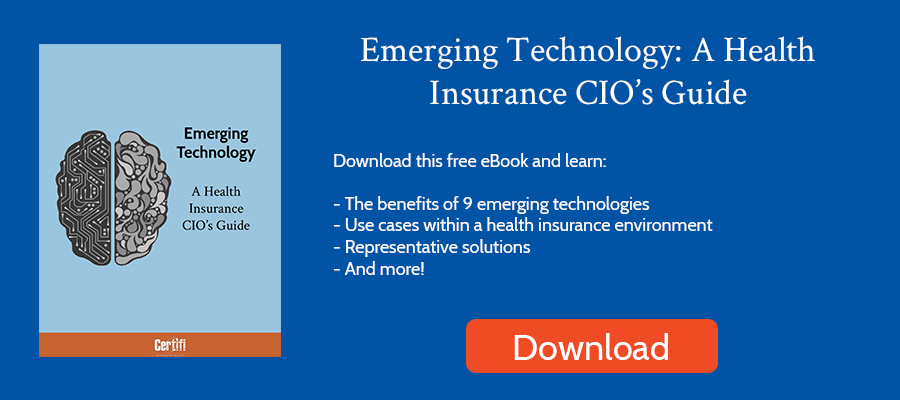A recent Gartner survey found that 70% of payers will spend more on cloud platforms in 2023 than they did in 2022. Why? Because cloud computing can positively impact health insurance data management.
Here are six reasons cloud computing is among the leading health insurance technology trends:
6 Reasons Cloud Computing is Among the Leading Health Insurance Technology Trends
-
- Scalability
- Cost-effectiveness
- Flexibility
- Security
- Data Integration
- Faster Data Processing
Scalability
Cloud computing allows health insurance companies to scale their data storage and processing capabilities quickly and easily, which is particularly important when managing large amounts of data.
Our premium billing solution leverages Amazon Web Services (AWS) elastic computing resources to add computing power during critical times of the month. For example, generating invoice transactions for hundreds of thousands or millions of groups or members can be a resource-intensive process that occurs on a particular day every month. To create those invoice transactions quickly, we dynamically add computing resources. We then remove those resources when transaction generation is complete. As a result, we can have more computing resources than a traditional on-premise solution when creating financial transactions.
Cost-effectiveness
Using cloud-based services eliminates the need for health insurance companies to invest in expensive hardware and infrastructure to manage their data, reducing costs.
Take the previous example. By only accessing additional computing resources one day a month to generate monthly billing transactions, the cost of computing power is much less compared to purchasing or maintaining static resources. Creating invoices, especially for large populations, can take significantly longer to generate without significant computing power. Extended processing times can lead to other issues – like inaccurate invoices due to payments arriving during invoice generation – that worsen the member experience.
Flexibility
Cloud computing allows health insurance companies to access their data from anywhere and on any device, making it easier to work remotely and collaborate. That flexibility leads to more agile operations, making it easier for health plans to respond quickly to market and customer needs.
Cloud solutions also deliver access to innovation that on-premise solutions may not. Most cloud computing providers have periodic release cycles that add new features more frequently than their on-premise counterparts. And leveraging those new features doesn’t involve any complicated upgrade procedures. New features appear post-release.
Security
Cloud computing providers typically have robust security measures designed to protect against data breaches and cyber threats, which can provide health insurance companies with greater peace of mind.
Those security protocols include:
- Physical Security – Cloud providers have enhanced physical security, including security guards, access control, and video surveillance, that can be costly for individual businesses to implement.
- Data Encryption – Cloud providers use encryption for data at rest and in transit, making it more difficult for unauthorized users to access sensitive information.
- Advanced Threat Detection – Cloud providers use advanced threat detection tools to identify security threats before they cause damage.
- Compliance with Regulatory Standards – Cloud providers are subject to compliance and regulatory standards – like HIPAA, PCI-DSS, and GDPR – so have implemented specific processes and features to protect user data.
Data Integration
Cloud computing allows health insurance companies to integrate data from multiple sources, making it easier to analyze and use this data to improve health outcomes.
That data integration capability enables insurers to take a modular approach to technology infrastructure. For example, years ago many insurers purchased on-premise core administration solutions that included premium billing functionality. As they transition to the cloud, they find that integrating modular premium billing solutions delivers more feature-rich solutions – like integrated delinquency management or payment portals – that easily integrate with upstream enrollment platforms and downstream general ledger solutions.
Cloud platforms built to integrate with other software solutions enable insurers to take advantage of modular solutions, thus improving the overall performance of their technology stacks.
Faster Data Processing
We discussed how cloud computing improves scalability, leading to faster transaction generation. But that’s not the only way cloud software can lead to faster processing. Other attributes include:
- High-performance computing: Many cloud solutions use powerful computing resources to process data quickly. For applications that require large amounts of data processing, such as machine learning, high-performance computing improves processing speed.
- Optimization: Cloud solutions optimize data processing performance by using specialized hardware or software. For example, some cloud solutions use solid-state drives (SSDs) instead of traditional hard drives to improve data access times.
- Reduced latency: Cloud solutions often are closer to end-users, reducing latency when transmitting data between locations. That can improve data processing times, particularly for applications that require real-time data processing.
Cloud computing has enabled health insurance companies to manage data more efficiently and effectively. Additionally, cloud solutions reduce costs and improve security. It has also provided new opportunities to leverage data to improve health outcomes while improving the member experience, both high-level goals for forward-thinking payers.
Certifi’s health insurance premium billing and payment solutions help healthcare payers improve member satisfaction while reducing administrative costs.



